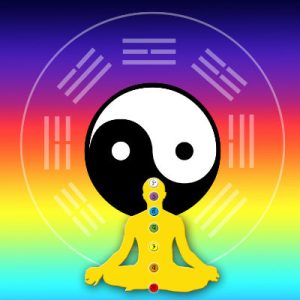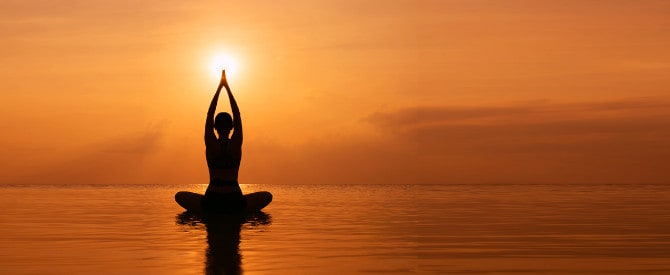If you’re into yoga and have attended classes at an authentic yoga studio, the exercises most likely originated from the yogic practices of Hatha Yoga. Hatha yoga is commonly misunderstood to be merely physical postures or asanas. However, it is its own multifaceted school of yoga. This article gives a basic understanding of Hatha Yoga and its five main practices.
What is Hatha Yoga?
What do the words, ‘Hatha’ and ‘yoga’, mean?
The word ‘Hatha’ comes from the union of two Sanskrit letters: ‘ha’ and ‘tha’. ‘Ha’ means the sun, and ‘tha’ means the moon.
 The sun and the moon channels of energy are the two major channels or nadis located in the nostrils. Cosmic energy riding on the breath we take in enters the body through these two channels. It then connects to an intricate network of thousands of nadis that maintain a healthy flow of energy in the body.
The sun and the moon channels of energy are the two major channels or nadis located in the nostrils. Cosmic energy riding on the breath we take in enters the body through these two channels. It then connects to an intricate network of thousands of nadis that maintain a healthy flow of energy in the body.
The sun or surya nadi is in the right nostril, and the moon or Chandra nadi is in the left.
Just as the sun energizes us and makes us feel active and alert, the energy entering the sun channel (right nostril) stimulates the body systems. It also impacts the functioning of the left brain and the sympathetic nervous system which helps to prepare the body to meet stressful situations.
The next time you experience brain fog and lethargy, close the left nostril and breathe only through the right nostril for a few minutes. It will boost your energy and mental clarity.
The energy entering the Chandra nadi (left nostril) influences the functioning of the right hemisphere of the brain and is connected to the parasympathetic nervous system. The parasympathetic nervous system is designed to slow down processes and bring the body back to normal after a stressful situation. It calms the mind, repairs tissues, and restores balance.
If you have an overactive mind or are experiencing some negative emotions or worry, close the right nostril and breathe through the left for a few minutes. This will help to calm down your emotions.
The practices of Hatha Yoga help to harmonize the energy coming in through the two nostrils, thereby facilitating homeostasis or inner equilibrium. This is why Hatha Yoga is also called the Yoga of Balance.
The word, ‘yoga’ comes from the Sanskrit root, ‘yuj’ which means ‘to unite’. Yoga helps to integrate or unite the different dimensions of the human personality. The body, emotions and mind come into a peaceful alignment through the regular practice of yoga.
From a spiritual perspective, yoga is a path or means that unites the individual soul with the Supreme Soul.
The individual soul (you and I) and the Supreme Soul or Ultimate Cause are already one. The separation is merely an illusion. This illusion is sustained by the mind which is made up of thoughts. The mind identifies with the limited body and thinks itself to be an individual, small and separate.
The regular practice of yoga helps to arrest the intervening factor—the thoughts, and brings about the union of the individual soul and the Supreme Soul (Self). The yogi who attains this oneness is liberated from the illusion of smallness and separation.
Hatha yoga strives to achieve this goal through a path that is physically oriented.
The 5 practices of Hatha Yoga
Hatha yoga practices start with the body and prepare the practitioner for reaching higher states of consciousness.
Here are the 5 core practices in Hatha Yoga listed in the order that they are performed:
- Kriyas — purification practices.
- Asanas — physical body exercises.
- Pranayama — exercises that regulate the breath.
- Bandhas — energetic locks.
- Mudras — hand gestures.
Kriyas first purify the body. Asanas strengthen the body and keep it healthy. Pranayama practices make the body light. Bandhas and mudras steady the body and mind and prepare it for meditation. Regular and long practice of meditation leads to spiritual absorption or union with the Self.
#1 Kriyas — purification practices
They are six Kriyas:
- Kapalabhati — A breathing technique that cleanses the frontal lobes of the brain (kapala = forehead) and the lungs. It removes phlegm and toxins from the sinuses and respiratory passages. It bring a glow to the face (bhati= shining), physical energy and mental clarity.
- Trataka —This is sometimes called candle gazing. It cleanses the eyes and strengthens the vision. It is also helps to improve concentration and a great technique to prepare for meditation.
- Neti — cleansing of the nasal passages. Jala Neti (jala = water) is done by pouring saline water into the nostrils using a neti pot. In Sutra Neti (Sutra = thread or string), a narrow rubber catheter is gently inserted into one of the nostrils and allowed to drop down to the back of the mouth. The practitioner then pulls the catheter out of the mouth. The sutra is then alternatively pulled through the nostril and mouth.
- Dhauti — cleansing of the digestive tract. A form of dhauti that most people can do is called vaman dhauti. In this method, six cups of warm, saline water are drunk quickly. The practitioner then puts a finger at the back of the throat to trigger the vomiting response. The water all comes gushing out bringing along with it toxins and other waste form the stomach.
- Nauli — massaging of the abdomen using the muscles of the abdomen. The muscles are trained to do circular movements that massage the small intestine and facilitate the cleansing of toxins.
- Basti — cleansing of the colon. This involves taking enemas and cleansing the large intestine.
#2 Asanas
 Asanas are yoga postures. The word, ‘Asana’ comes from the root word, ‘aas’ which means ‘to sit’ or a ‘state of existence’.
Asanas are yoga postures. The word, ‘Asana’ comes from the root word, ‘aas’ which means ‘to sit’ or a ‘state of existence’.
Yogasanas (yoga postures) often imitate animals and nature. Some examples are the cobra, swan, mountain and tree postures.
Asanas can be practiced in a dynamic way with speed and repetitions to gain strength and stamina, or in a relaxing way which emphasizes on mental equipoise through relaxation.
The latter method is based on the principles of yoga as propounded by Sage Patanjali, who is known as the Father of Yoga. Once the practitioner gets into a particular stance and the final posture is achieved, the body is held steady in a comfortable way without straining.
The duration in which the posture is held is gradually increased over time. The body slowly becomes strong and steady, yet relaxed. With regular practice in this way, the mind becomes quiet. The practitioner is then able to expand his/her small ego awareness to an all-pervasive awareness and merge into a state of silence.
#3 Pranayama
 The word, ‘pranayama’ is broken up into ‘prana’ which means the vital force or cosmic energy and ‘ayama’ which means ‘control’ or ‘regulate’.
The word, ‘pranayama’ is broken up into ‘prana’ which means the vital force or cosmic energy and ‘ayama’ which means ‘control’ or ‘regulate’.
Since cosmic energy rides on the breath we take in, the practice of pranayama aims to regulate and balance this flow of energy in the body through breathing exercises.
Pranayama practices focus on expanding and prolonging the inhalation (puraka), exhalation (rechaka), and retention (kumbhaka). In kumbhaka, the breath can be held internally after inhalation or externally after exhalation.
#4 Bandhas
Bandhas are yogic locks that shut off the flow of energy from certain parts of the body and direct them to the parts that a practitioner want it to go. The four main bandhas are mula bandha performed for the pelvic floor muscles, Uddiyana bandha for the abdominals up to the diaphragm and Jalandhara bandha for the throat. Maha bandha is a combination of all three of the bandhas above.
#5 Mudras
A mudra is a special hand gesture that is adopted to remove imbalances in the elements of space, air, fire, water and earth in the body.
Each of the five fingers are connected to a particular element. The thumb is connected to fire, index finger to air, middle finger to space, ring finger to earth and little finger to water.
Imbalances can be removed by connecting one part of the body with another in a specific way through the practice of special mudras. Some common mudras are Chin mudra, Chinmaya mudra, Adi mudra, and Brahma mudra.
 Total Transformation
Total Transformation
Hatha yoga is a complete system for the restoration and maintenance of vibrant health and the advancement of inner growth.
A person seeking natural and holistic solutions for physical and mental health, as well as inner transformation will surely benefit from the practices of Hatha Yoga.
Like this post? Sign up for the free fortnightly Spiritual Solutions Newsletter and receive the latest articles, news and updates in your email inbox!














Thank you madam,
Your article on Hatha yoga is very impressive.
I wish to read your other articles, also kindly send your spiritual solutions newsletter to my email address
Thank you.
Thank you Rohini for reading and your interest in receiving more articles from me. I have added your email address to my subscriber list.
Thank you madam